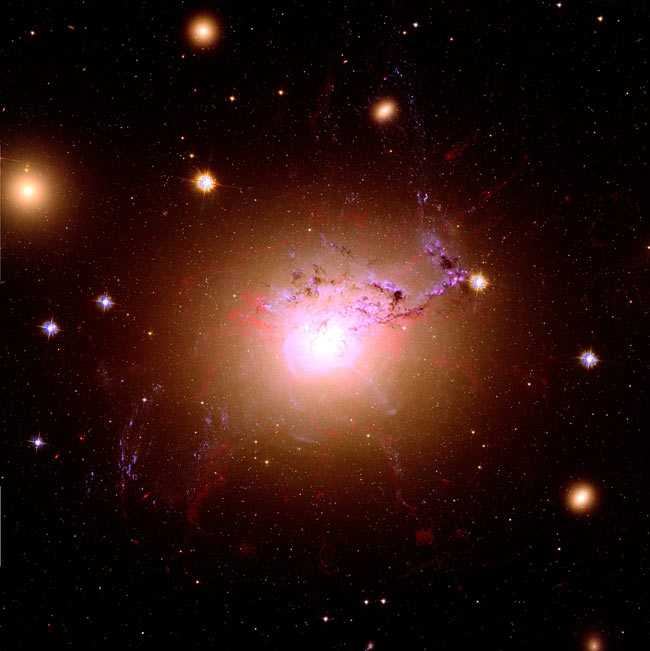Space 'Ropes' Hang Together by Threads

Scientists have discovered the forces that bind together a strangenetwork of 100-million-year-old, rope-like gas filaments that extend from anenormous elliptical galaxy.
The filaments presented a puzzle because they should normallycollapse under the pressure of the hotter surrounding gas. New images from the Hubble SpaceTelescope showed individual gas threads bundled together within thefilaments, which allowed researchers to estimate the magnetic fields necessaryto hold everything together.
"When you see a piece of rope from a distance it looks solid,but when you look closely there's a lot of threads," said Andrew Fabian,an astrophysicist at the University of Cambridge, U.K., who led the studydetailed in this week's issue of the journal Nature.
Previous images of the galaxy NGC 1275 barely showed bits of thefilaments, but Hubble's snapshots improved the view with 10 times more detail.Individual threads now appear to stretch about 20,000 light-years. (A light-yearis thedistance light will travel in a year, or about 6 trillion miles or 10 trillionkilometers.)
"It's not an astounding surprise, but the thing we can do iscalculate the magnitude of the magnetic field from the size of thefilaments," Fabian told SPACE.com. "Everything checksout."
The filaments may represent the most visible effect of thegalaxy's central black hole on its gaseous surroundings. The black hole's high-energyjets have heated up the gas to about 70 million degrees Fahrenheit (40million Kelvin), which in turn produces glowing bubbles that float outward fromthe galaxy center.
The bubbles pull colder gas outward behind them in the form of thetrailing filaments. Some filaments extend in radial lines outward from thegalaxy center, while others appear as horseshoe shapes.
Get the Space.com Newsletter
Breaking space news, the latest updates on rocket launches, skywatching events and more!
Cold gas within the filaments could normally begin to condense andstartforming stars, but the filaments' magnetic fields push against thegravitational pressure and prevent star-birth.
Fabian and his study coauthors from the U.K. and United States seeNGC 1275 as just the closest example of many objects that could have filamentstructures.
"It's known that many distant, massive galaxies aresurrounded by nebulae of gas which must be filamentary or clumpy," Fabiannoted. "We think similar filaments are there in those distantobjects."
- Video: Black Hole Blazar Jets
- Video: Our Corner of the Cosmos
- Vote for Your Favorite All-time Hubble Image
Join our Space Forums to keep talking space on the latest missions, night sky and more! And if you have a news tip, correction or comment, let us know at: community@space.com.
Jeremy Hsu is science writer based in New York City whose work has appeared in Scientific American, Discovery Magazine, Backchannel, Wired.com and IEEE Spectrum, among others. He joined the Space.com and Live Science teams in 2010 as a Senior Writer and is currently the Editor-in-Chief of Indicate Media. Jeremy studied history and sociology of science at the University of Pennsylvania, and earned a master's degree in journalism from the NYU Science, Health and Environmental Reporting Program. You can find Jeremy's latest project on Twitter.









